Buddhists Needed by EvergreenHealth Hospice
To Help Seattle-area People Move into Death
Written by: Moses Tovar

Volunteer Julia Guderian with patient Roberta M, warmed by a blanket that Guderian’s son’s class knit for this hospice patient.
Photos by: Criss East
As the population of Western Washington becomes more diverse, EvergreenHealth Hospice Care is seeking Buddhist volunteers to support people in the last stages of their lives.
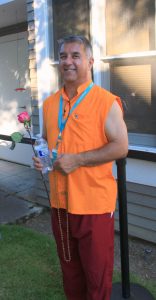
Author Moses Tovar volunteers at the annual Rose Garden Memorial Ceremony, where we invite families back to remember their loved ones.
Already about 250 people volunteer to support people as they near death, with the program supporting more than 3,000 patients in 2016, said Volunteer Coordinator Criss East. Currently only enough volunteers are available to fill half the requests.
“It is important for us to expand our volunteer program to include Buddhists as well as volunteers from other religious backgrounds,” East said. “The population we serve is comprised of many cultures. When we serve immigrants, it is comforting to them to be served by a volunteer to whom they can relate.”
Based in Kirkland, Washington, Evergreen Health Hospice Care is a unit of the EvergreenHealth medical center. Evergreen’s Gene and Irene Wockner Hospice Care Center, the first free-standing hospice center in Washington, offers 15 beds.
As a Buddhist practitioner and author of this article, I do my best to understand that at any given moment, my death may happen. I must be as prepared as I can be for that final journey, from this life to the next.
As Buddhists we generate compassion through our prayers and meditations. We believe that through compassion we will be able to best understand and help other beings. This is when we can remind ourselves that unless we put action into our prayers and positive energies, they remain just wishes and aspirations.
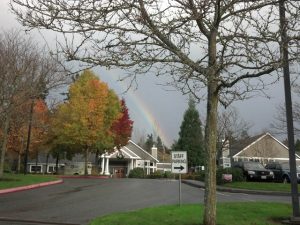
A rainbow arcs over the Gene and Irene Wockner Hospice Center in Kirkland.
In 2012, when I made the conscious decision to explore how I could help others and myself deal with the issues of death and dying, it put me on the path to my second home, EvergreenHealth Hospice Care. My first home is my guru and sangha, Sakya Monastery of Tibetan Buddhism in Seattle.
Evergreen Health Hospice Care is led by three wonderful, inspiring, compassionate and caring volunteer coordinators: Sheri Standley, Melissa Lubatti and East. Their hard work, devotion and dedication to this program are truly a blessing.
The training is phenomenal, and ongoing. Volunteers are continually kept up to date through emails, lectures, tele-conferences, guest speakers and hospice volunteer events. Volunteers even have their own Facebook page.
Evergreen Hospice offers volunteer training six times yearly, over three 8-hour days, teaching volunteers to be comfortable serving people at the end of life.
The training includes the history and philosophy of hospice, and an exercise about what it might be like to be dying.
Volunteers learn about boundaries, compassionate presence, symptoms at end of life, and finish with practical ways to spend time with hospice patients.
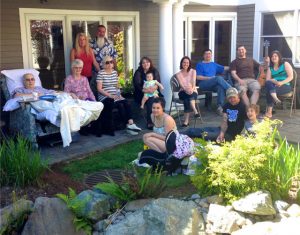
Hospice Volunteer Douglas Treuting brought patient and family outside to the courtyard, on a lovely spring day at the hospice center.
Volunteers can offer support in many ways. If visiting a patient in a skilled nursing facility, the volunteer may sit quietly with a patient, hold their hand, and play some soft music or speak softly to them. These are short visits, no more than one hour once a week.
Other patients may want to work on a life review to get their stories down on paper for their loved ones. Other things volunteers do are to read emails to patients and then transcribe the reply back, to write letters for the patient, or to offer light housekeeping or run errands. Volunteers can also stay with the patient so the caregiver can have a break for self-care. This is our largest need.
East said she has seen that Buddhists, with their focus on the contemplative life and the transience of life, often do well as hospice volunteers.
“We accept volunteers from any faith tradition,” she said. “But we find that Buddhist volunteers come to the program with built-in skills for this kind of volunteer work, and the work seems to enhance their Buddhist practice.”
Great learning as hospice volunteer
After the initial training I chose to be a field hospice volunteer. I visit people in nursing facilities, assisted living, adult family homes, and some in their own homes. As I was learning how to apply my hospice training to my visits, I found myself learning how to apply Buddhist teachings to the process, particularly compassion.
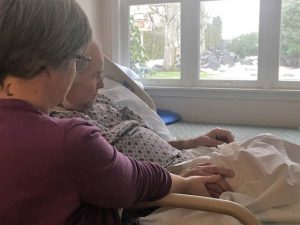
Hospice volunteer Julia Guderian massages the hands of a patient at the hospice center.
Generosity, patience and wisdom are needed in order to be present and open to people who are dealing with what is considered the greatest mystery of all, death.
I have a sangha friend whose mother passed away this past holiday season. They were wonderfully close and had a very special bond. It was a saddening blow, not only to my friend but for all who knew his mother.
I feel lucky to have met and walked with the mother, even if only for a short time. Even though I am not particularly close to this man I reached out through an email, offering any assistance that he might need. I was very happy when he contacted me to come help him organize his mother’s belongings.
I arrived at my friend’s house at the agreed-upon time. He is a Buddhist practitioner of great depth in several different traditions and lineages. I was a little nervous because we have known each other only at our temple and through emails. My nerves were soon relieved as I sat down and we talked. And talked. And as we talked into the night it finally dawned on me that we weren’t going to get a lot of work done, if any. Or were we?
After this first visit with my friend, I realized something. I had slipped into “hospice mode” without noticing. This included listening more, instead of talking. This including knowing that those long silences were providing space for my friend to process his grief, and when and how to share and not let my ego take over.
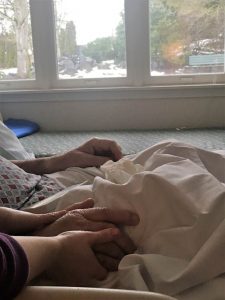
Compassion links volunteers and patients.
All the training just kicked in. Then I realized and recognized the training is also present in Buddhist teachings. The teachings include generosity, reaching out to another person, compassion for someone who has lost a loved one, patience through those long silences. It also includes the wisdom to know when to keep my big mouth shut.
The patient and family need support by people who can remain calm and who are comfortable with silence. Volunteers model calm, compassionate presence, and show that death is normal. They are there as an additional support to the patient and family.
Paid hospice staff are there for specific purposes including medications and funeral arrangements, but the volunteer is visiting with no agenda other than to be with that patient.
Hospice strives to bring quality to the last days of life, a stark comparison to dying tethered to life support machines in a chaotic ICU.
It doesn’t matter what faith or spiritual path you follow as a hospice volunteer. What’s important is that you recognize your compassion and want to put it into action.
Buddhist practice has helped me serve in hospice care, because of the importance of the fundamental Buddhist concepts of generosity, loving-kindness, patience and compassion.
Has hospice volunteering helped me in my Buddhist practice? In this there is no doubt. Helping people face their fears, their doubts, their death, has helped me deal with my own issues with death and dying , and has been and continues to be an inspiring and humbling experience.
I feel genuinely blessed to be able to serve in this way. I encourage everyone to find some way to volunteer and serve in your own communities, and make a better world to live in.
